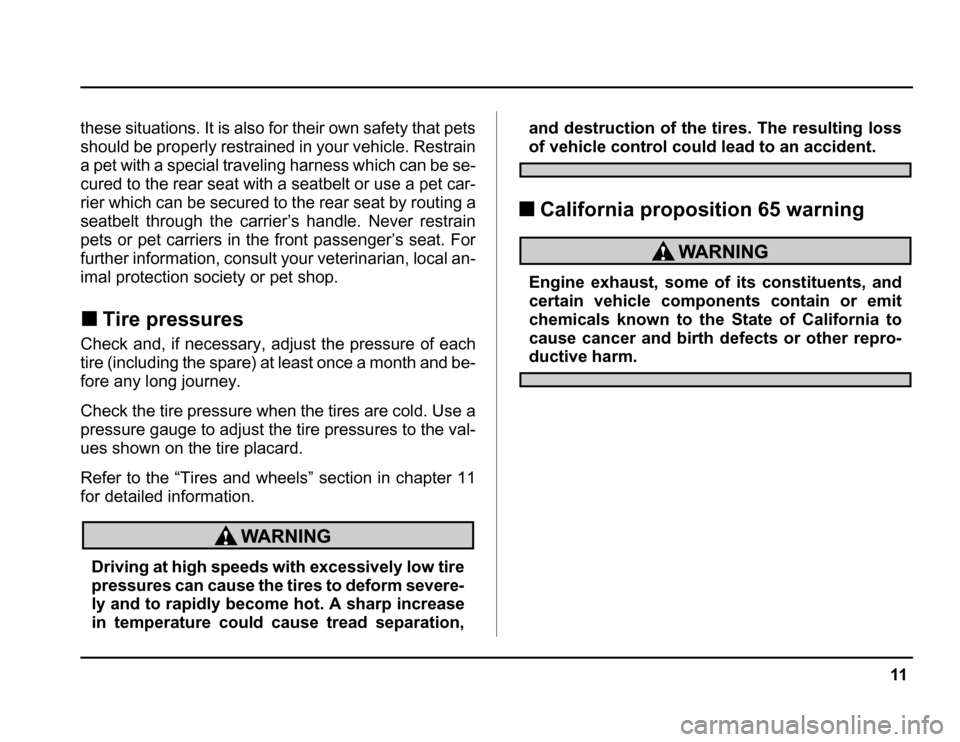Page 14 of 420

11
–
CONTINUED –
these situations. It is also for their own safety that pets
should be properly restrained in your vehicle. Restrain
a pet with a special traveling harness which can be se-
cured to the rear seat with a seatbelt or use a pet car-
rier which can be secured to the rear seat by routing a
seatbelt through the carrier’s handle. Never restrain
pets or pet carriers in the front passenger’s seat. For
further information, consult yo ur veterinarian, local an-
imal protection society or pet shop. � Tire pressures
Check and, if necessary, adjust the pressure of each
tire (including the spare) at least once a month and be-
fore any long journey.
Check the tire pressure when the tires are cold. Use a
pressure gauge to adjust the tire pressures to the val-
ues shown on the tire placard.
Refer to the “Tires and wheels” section in chapter 11
for detailed information.
Driving at high speeds with excessively low tire
pressures can cause the tires to deform severe-
ly and to rapidly become hot. A sharp increase
in temperature could cause tread separation, and destruction of the tires. The resulting loss
of vehicle control could lead to an accident.
� California proposition 65 warning
Engine exhaust, some of its constituents, and
certain vehicle components contain or emit
chemicals known to the State of California to
cause cancer and birth defects or other repro-
ductive harm.
Page 109 of 420
2-18
Keys and doors
1) Connector for SRS airbag system (yellow)
2) White (1P)
2. Connect the white (1 pole) connector.
3. Turn the ignition switch from the “LOCK” to the
“ON” position.
4. Install the side sill cover.
To place the system in active arming mode (remote re-
quired for activation), disconnect the white connector.
Do not disconnect or tamper with any yellow
connector and/or any harness covered with yel- low insulation and/or tape.
Doing so could result in accidental inflation of
the SRS airbag or could make the SRS airbag
system inoperative, which may result in serious
injury.
� Arming the system
1. Turn the ignition switch to the “ON” position.
1) ON
2) LOCK
2. Turn the ignition switch from “ON” to “LOCK” posi-
tion and remove the key from the ignition switch.1
2
HS2023BB1
2
1
2
HS2024BB
Page 279 of 420

8-10
Driving tips
starting.
Keep the door locks from freezing by squirting them
with deicer or glycerin.
Forcing a frozen door open may damage or separate
the rubber weather strips around the door. If the door
is frozen, use hot water to melt the ice, and afterwards
thoroughly wipe the water away.
Use a windshield washer fluid that contains an anti-
freeze solution. Do not use engine antifreeze or other
substitutes because they may damage the paint of the
vehicle. �
Before driving your vehicle
Before entering the vehicle, remove any snow or ice
from your shoes because that could make the pedals
slippery and dangerous.
While warming up the vehicle before driving, check
that the accelerator pedal, brake pedal, and all other
controls operate smoothly.
Clear away ice and snow that has accumulated under
the fenders to avoid making steering difficult. During
severe winter driving, stop when and where it is safe
to do so and check under the fenders periodically. �
Parkingincoldweather
Do not use the parking brake when parking for long
periods in cold weather since it could freeze in that po-
sition. Instead, observe the following:
1. Place the shift lever in “1” or “R” for manual trans-
mission vehicles, and in “P” for automatic transmission
vehicles.
2. Use tire stops under the tires to prevent the vehicle
from moving.
When the vehicle is parked in snow or when it snows,
raise the wiper blades off the glass to prevent damage
to them.
When the vehicle has been left parked after use on
roads heavily covered with snow, or has been left
parked during a snowstorm, icing may develop on the
brake system, which could cause poor braking action.
Check for snow or ice buildup on the suspension, disc
brakes and brake hoses underneath the vehicle.
If there is caked snow or ice, remove it, being careful
not to damage the disc brakes and brake hoses and
ABS harness.
Snow can trap dangerous exhaust gases under
your vehicle. Keep snow clear of the exhaust
Page 293 of 420
8-24
Driving tips
ground.
Do not connect safety chains to part of the ve-
hicle other than the safety chain hooks.
Hitch harness connector
8. Connect the hitch wire harness’s black four-pin
wire connector to the towing trailer’s wire harness
9. Confirm proper function of the hitch wire harness
by individually activating the brake, right turn signal,
left turn signal, stop, and parking lights on the trailer.
NOTE
Always disconnect the trailer wire harness before
launching or retrieving a watercraft. � When you do not tow a trailer
� Remove the ball mount from the hitch receiver tube
and insert the receiver cover onto the hitch receiver tube. � Place the dust cap over the fou-pin connector of the
hitch wire harness to protect against possible damage. � Occasionally lubricate terminals of the four-pin con-
nector using terminal grease.
HS8015BA
Page 381 of 420
11 - 5 0
Maintenance and service
It is unnecessary to periodically check the battery fluid
level or periodically refill with distilled water.
However, if the battery fluid level is below the lower
level, remove the cap. Fill to the upper level with dis-
tilled water.
Never use more than 10 amperes when charg-
ing the battery because it will shorten battery
life.
Fuses
Never replace a fuse with one having a higher
rating or with material other than a fuse be-
cause serious damage or a fire could result.
The fuses are designed to melt during an overload to
prevent damage to the wiring harness and electrical
equipment. The fuses are located in two fuse boxes.
One is located under the instrument panel behind the
coin tray on the driver’s seat side.
HSB064BA
Page 384 of 420
11 -5 3
Maintenance and service
–CONTINUED –
Main fuse
Main fuse box
The main fuses are designed to melt during an over-
load to prevent damage to the wiring harness and
electrical equipment. Check the main fuses if any elec-
trical component fails to operate (except the starter
motor) and other fuses are good. A melted main fuse
must be replaced. Use only replacements with the
same specified rating as the melted main fuse. If a
main fuse blows after it is replaced, have the electrical
system checked by your nearest SUBARU dealer.Installation of accessories
Always consult your SUBARU dealer before installing
fog lights or any other electrical equipment in your ve-
hicle. Such accessories may cause the electronic sys-
tem to malfunction if they are incorrectly installed or if
they are not suited for the vehicle.
HSB065BA